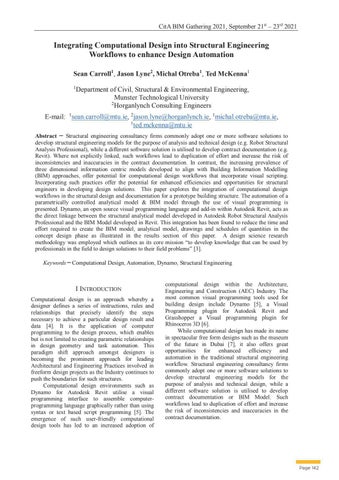CitA BIM Gathering 2021, September 21st – 23rd 2021
Integrating Computational Design into Structural Engineering Workflows to enhance Design Automation Sean Carroll1, Jason Lyne2, Michal Otreba1, Ted McKenna1 1
Department of Civil, Structural & Environmental Engineering, Munster Technological University 2 Horganlynch Consulting Engineers
E-mail: 1sean.carroll@mtu.ie, 2jason.lyne@horganlynch.ie, 1michal.otreba@mtu.ie, 1 ted.mckenna@mtu.ie Abstract ̶ Structural engineering consultancy firms commonly adopt one or more software solutions to develop structural engineering models for the purpose of analysis and technical design (e.g. Robot Structural Analysis Professional), while a different software solution is utilised to develop contract documentation (e.g. Revit). Where not explicitly linked, such workflows lead to duplication of effort and increase the risk of inconsistencies and inaccuracies in the contract documentation. In contrast, the increasing prevalence of three dimensional information centric models developed to align with Building Information Modelling (BIM) approaches, offer potential for computational design workflows that incorporate visual scripting. Incorporating such practices offer the potential for enhanced efficiencies and opportunities for structural engineers in developing design solutions. This paper explores the integration of computational design workflows in the structural design and documentation for a prototype building structure. The automation of a parametrically controlled analytical model & BIM model through the use of visual programming is presented. Dynamo, an open source visual programming language and add-in within Autodesk Revit, acts as the direct linkage between the structural analytical model developed in Autodesk Robot Structural Analysis Professional and the BIM Model developed in Revit. This integration has been found to reduce the time and effort required to create the BIM model, analytical model, drawings and schedules of quantities in the concept design phase as illustrated in the results section of this paper. A design science research methodology was employed which outlines as its core mission “to develop knowledge that can be used by professionals in the field to design solutions to their field problems” [3]. Keywords ̶ Computational Design, Automation, Dynamo, Structural Engineering
I INTRODUCTION Computational design is an approach whereby a designer defines a series of instructions, rules and relationships that precisely identify the steps necessary to achieve a particular design result and data [4]. It is the application of computer programming to the design process, which enables but is not limited to creating parametric relationships in design geometry and task automation. This paradigm shift approach amongst designers is becoming the prominent approach for leading Architectural and Engineering Practices involved in freeform design projects as the Industry continues to push the boundaries for such structures. Computational design environments such as Dynamo for Autodesk Revit utilise a visual programming interface to assemble computerprogramming language graphically rather than using syntax or text based script programming [5]. The emergence of such user-friendly computational design tools has led to an increased adoption of
computational design within the Architecture, Engineering and Construction (AEC) Industry. The most common visual programming tools used for building design include Dynamo [5], a Visual Programming plugin for Autodesk Revit and Grasshopper a Visual programming plugin for Rhinoceros 3D [6]. While computational design has made its name in spectacular free form designs such as the museum of the future in Dubai [7], it also offers great opportunities for enhanced efficiency and automation in the traditional structural engineering workflow. Structural engineering consultancy firms commonly adopt one or more software solutions to develop structural engineering models for the purpose of analysis and technical design, while a different software solution is utilised to develop contract documentation or BIM Model. Such workflows lead to duplication of effort and increase the risk of inconsistencies and inaccuracies in the contract documentation.
Page 142


















